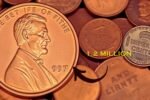A Viral Claim Sparks Curiosity
Rumors of a Lincoln Wheat Penny valued at $13 million, supposedly still in circulation, have ignited excitement across platforms like X and sites such as basirhatpolice.org and kmckatni.org. This iconic coin, minted from 1909 to 1958, is a collector’s favorite due to its historical significance and rare variants. However, the $13 million figure, often tied to the 1943 Copper Wheat Penny or other error coins, lacks credible evidence. Top auction records show a 1943-D Bronze Penny sold for $1.7 million in 2010, far below $13 million. Let’s unpack the truth behind this sensational claim.
Why Are Some Pennies So Valuable?
The Lincoln Wheat Penny, designed by Victor D. Brenner, features Abraham Lincoln’s portrait and wheat stalks symbolizing prosperity. During World War II, copper shortages led the U.S. Mint to produce 1943 pennies from zinc-coated steel. A few bronze planchets from 1942 were mistakenly struck, creating the ultra-rare 1943 Copper Penny (15-20 known, valued up to $1.7 million). Similarly, 1944 steel pennies (20-40 known, up to $408,000) resulted from leftover 1943 steel planchets. These errors, along with low-mintage coins like the 1909-S VDB (~484,000 minted, up to $168,000), drive high values. The $13 million claim likely exaggerates these rarities or confuses them with speculative estimates for pristine, unrecorded variants.
True Values of Rare Wheat Pennies
Based on verified auction data, here are key Lincoln Wheat Pennies and their values:
- 1943-D Bronze Penny: One known, sold for $1.7 million (2010). Estimated value: $2.3 million in MS64.
- 1943-S Bronze Penny: Few known, sold for $282,000 (2016). Estimated: $200,000-$500,000.
- 1944-S Steel Penny: Two known, sold for $408,000 (2021). Estimated: ~$399,637.
- 1909-S VDB Penny: ~484,000 minted, up to $168,000 in MS67 red.
- 1955 Double Die Obverse: ~20,000-24,000 minted, sold for $336,000 (2018). Estimated: $10,000-$50,000 in high grades.
The $13 million figure, cited in sources like basirhatpolice.org, appears unverified, possibly inflating values for clicks. No Wheat Penny has ever sold for over $2.3 million.
How to Identify a Valuable Penny
To check if you have a rare Lincoln Wheat Penny:
- Date & Mint Mark: Look for 1943 (copper), 1944 (steel), 1909-S VDB, or 1955 (double die). Mint marks: “D” (Denver), “S” (San Francisco), or none (Philadelphia).
- Magnet Test: 1943 copper pennies (3.11g) don’t stick to magnets; steel pennies (2.7g) do. 1944 steel pennies are magnetic; copper ones aren’t.
- Condition: Mint State (MS60+) coins fetch higher prices. Avoid cleaning, as it reduces value.
- Errors: Check for double-die errors (e.g., doubled “LIBERTY” on 1955) or unusual metal color.
Authenticate finds via PCGS or NGC to avoid counterfeits (e.g., copper-plated 1943 steel pennies).
Is It Still in Circulation?
Theoretically, a rare 1943 copper or 1944 steel penny could remain in circulation, as some were found in change historically (e.g., Don Lutes’ 1943 copper penny, sold for $204,000 in 2019). However, with only 15-40 of each known, most are likely in collections or identified by dealers. X posts fuel the “still circulating” narrative, but the odds are minuscule—more likely in old jars or inherited coins than pocket change. The $13 million claim lacks evidence of an unrecorded specimen commanding such a price.
The Reality Check
The Lincoln Wheat Penny’s top rarities, like the 1943 Copper or 1944 Steel, are worth $100,000-$1.7 million, not $13 million. Exaggerated claims from sources like kmckatni.org and basirhatpolice.org inflate values, possibly confusing the 1943 copper penny’s $1.7 million record or speculating on an undiscovered MS70 variant. Check your coins with a magnet, weigh them (3.11g for copper, 2.7g for steel), and consult PCGS or NGC for authentication. Visit pcgs.com or ngccoin.com for grading info. While a million-dollar penny is a thrilling prospect, $13 million is a myth keep hunting for those rare gems



